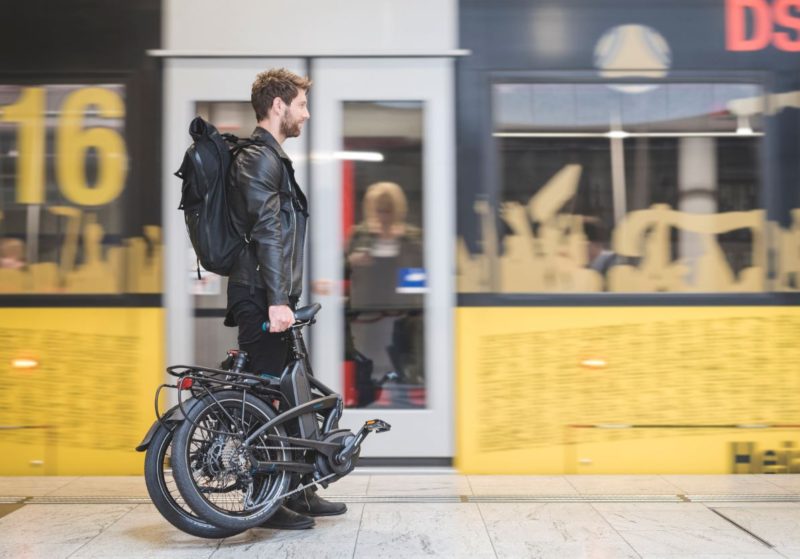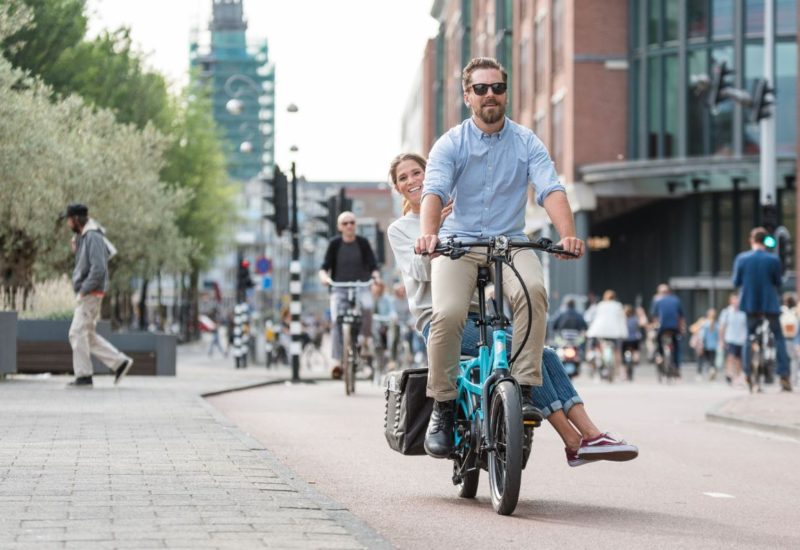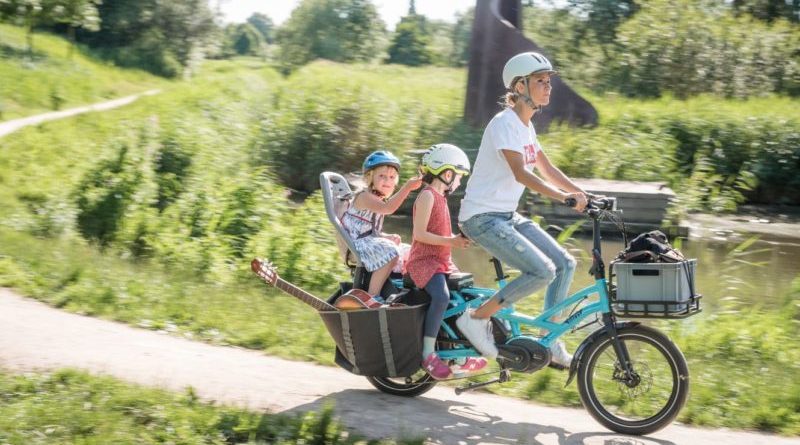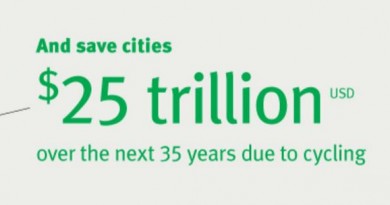Interview: Tern’s Josh Hon talks changing the mobility picture through design and advocacy
Cities around the globe have begun the urban mobility discussion in earnest. Perhaps guilty of putting too much emphasis on the sport to date, we gather the thoughts of Tern Bicycles founder Josh Hon on the successes and failures of the bike lobby to date…
 Tell us about your background in the bike business and how you came to focus on urban mobility:
Tell us about your background in the bike business and how you came to focus on urban mobility:
I rode a bike all through university but it was always as a means of transportation. Competition was always reserved for running and other sports. Cycling for me has always been about getting around and getting stuff done. Now, in my old age, cycling is also recreation but more about exploration and the social aspect of riding with friends and family.
Our focus on urban mobility really stems from our belief – and I say ‘our’ because most of the people at Tern believe in this strongly – that we need more bikes on the road. We believe that bikes play a critical role in the future of sustainable transportation.
Let’s talk about the bicycle’s current role in the transport picture; what cities get it right and what contributes to success?
There are a lot of cities working hard to increase ridership; this is incredibly encouraging for us. Of course we know cycling is great in places like Amsterdam and Copenhagen and many European cities. But we also see tremendous progress in places like New York, Buenos Aires and Taipei – places that not so many years ago were inhospitable to cycling.
Political will and money to invest in cycling infrastructure is critical to increasing ridership. If cycling only appeals to altruists who sacrifice their safety/comfort/time for the benefit of the planet, you won’t have many cyclists. Cities that invest in infrastructure to make cyclists feel safe will get more riders, as will those that invest in infrastructure to make bike commuting faster. The key is that when cycling just becomes a faster/cheaper way to get from A to B, there will be a lot more people who naturally become cyclists. Those of us in the bike industry are also critical because we need to design the bikes that make people feel safer and more comfortable and faster on their commutes.
If you say to 100 people, “you should cycle to work because it’s good for the planet”, maybe two or three out of those 100 might agree to change their behaviour. If you can say to those 100 people, “if you cycle to work you’ll save five minutes on your commute, and £50 a week on fuel”, then a lot more people will cycle to work. Make it less about altruism and more about selfishness and laziness. That’s when we’ll get the real numbers – and we can already see this in countries like the Netherlands and Denmark. In Copenhagen, for instance, about 40% of people get to work by bike because it’s simply the most convenient and cheapest way to do so.
What ratio do you envisage in five year’s time between electric and non-electric bikes?
Well, in a lot of European countries e-Bikes are already at 20-25% of all new bikes sold. In five years, I’d expect that number to be close to 50% for urban bikes that are used for transportation. It’ll take a lot longer in the US and Asia but I’d expect things to trend in that direction.
 Alongside electric bikes, how important will ‘smart bike’ technology become in cities?
Alongside electric bikes, how important will ‘smart bike’ technology become in cities?
“Smart bikes” has been a buzz term for some time now and I’ve had plenty of people telling me that we had to get into smart bikes. I was a sceptic then and am still a sceptic now.
I do believe that bikes will have more and more technology built into them – but I’m not a believer in building the capability of my smartphone into my bike. If I want to know my location or get directions, I’ve got my phone. If I want to check my riding history, I’ve got my phone. If I want to check my exercise levels, I’ve got my watch. If you try and build this stuff into a bike it’ll be obsolete before it gets there. No bike company is going to be able to keep pace with the technological development of Apple or Samsung. Even car manufacturers have given up and built phone integration and communication into their cars. Bikes will need to communicate with your phone or watch and they’ll have increasing amounts of tech built in, but this tech should be for improving safety or function.
My wish list for tech on a bike? Give me a battery with double the energy density (or half the weight).
What more could the bicycle industry be doing to push governments to better cater for cycling?
A lot of companies are working together to support cycling advocacy groups like People for Bikes or the European Cyclists Federation. These groups are doing good work and getting results. People for Bikes is pushing hard to get US states to adopt uniform rules for e-Bikes. The Bicycle Association in the UK is proposing that e-Bikes be covered under subsidies the government is offering to purchases of electric cars. These are all significant advances and larger budgets would help these groups do more. Unfortunately, Asia seems to lack a strong cycling advocacy group.
Seemingly, Tern has a broad view of what the perfect bike for city use could be – but what fundamental considerations end up on the drawing board when you design a new bike?
We always start from the perspective of the customer. Who is that customer and what do they want to do? Usually that customer is one or more of us on the Product Development team so we kind of know what we want. For example, one of the favourite features on the GSD is that it can be stood on its end and rolled easily into an elevator. No other bike designed to carry loads can fit in a lift. Why does the bike have this feature? Because I live in an apartment and without this feature, I can’t use this bike. It’s selfish, yes, but of course my living situation in a high-rise apartment is quite common. So I, and a lot of the members on the team, wanted a bike that could get us to work, could haul kids, help with grocery shopping – but, it had to fit into a lift.
We also design from a blank slate. We don’t confine ourselves with geometries, aesthetics, wheel sizes, or even price points (sometimes to the consternation of our CFO). We don’t concern ourselves with our competition either. We think about how we want the product to function for a certain type of customer and then we proceed from there. In the end the balance of features for the product has to make sense to us. True story: one of our largest distribution partners told us they didn’t want the GSD when we pitched the original concept. Fortunately, we ignored them. But we had the courage to do this because we, as customers, knew that the product was just too good.
The other thing is that we recognise customers and their needs are very different. For parents, maybe hauling kids is the most important thing. For retired couples, maybe being able to fold the bikes and get them into the car is the most important thing. That’s one thing I love about our team, we’re incredibly diverse and come at urban cycling from all angles. We’ve got team members in Europe, Asia, and the US – some living in super urbanised cities like Taipei; some living in the suburbs in Turku, Finland, and some living in bike-unfriendly Los Angeles. All of us face different challenges riding for transport and we bring those experiences to the product development table.
 Why do you think the GSD struck a chord with so many people?
Why do you think the GSD struck a chord with so many people?
With the GSD, we came at the project with the goal of designing an e-Bike optimised for urban usage. We had no restrictions on geometry, wheel size, components or aesthetics. The goal was – make it as useful as possible for the urban cyclist who needs to Get Stuff Done.
I think the GSD was successful because we created something original and, secondly, people agreed that what we created was what they wanted. Third, there’s not really any other bike that ticked all those boxes for functionality.
The encouraging thing is that we’ve got many more ideas where that came from. I feel that there is so much room to improve urban bicycles. If someone were to ask us to improve on the present crop of road bikes, we’d have a tough time. Today’s road bikes are so highly optimised, any improvements would be tiny. But improving a bike for urban usage? In comfort, safety, riding position, carrying cargo – there are so many possibilities.
Is the bike industry’s collective thinking showing signs of being ready to spend marketing dosh on transport cycling?
There are some companies doing good work marketing transport cycling. But we’re a small group and our budgets aren’t huge. No, I guess I don’t see the big boys spending too much on transport cycling yet, with the exception of Bosch, who is doing a fantastic job. Our segment isn’t sexy enough, yet. But as the transport cycling category grows, I’m sure the marketing dollars will follow.
To what extent does Tern get involved in political and bike advocacy efforts?
We support People for Bikes, the ECF and World Bike Relief. We also do smaller scale things too. For instance, we sent some Cargo Node bikes to Puerto Rico after the hurricane. The logistics of getting big cargo bikes to Puerto Rico when most commercial flights were shut down wasn’t easy, but one of our Tern riders stepped up and arranged everything with a small cargo company. He even paid for the transit since he said he appreciated us providing the bikes for free. Aren’t cyclists great? The bikes were used by his local cycling club to deliver water filters to people who were without clean water weeks after the hurricane.
 Last year we also held an event on our US e-commerce store donating all sales on 20 January, 2017 to the Natural Resources Defence Council, a group that fights hard to protect our nation’s natural resources: things like clean air and clean water. 20 January was the date of the presidential inauguration. Purely coincidental.
Last year we also held an event on our US e-commerce store donating all sales on 20 January, 2017 to the Natural Resources Defence Council, a group that fights hard to protect our nation’s natural resources: things like clean air and clean water. 20 January was the date of the presidential inauguration. Purely coincidental.
We donate 1% of our profits to cycling and social causes. We’re small, so the numbers have been small so far, but we look forward to contributing even more.
In the past 12 months where have key investments been made in the Tern brand?
Going forwards, our major investments will be in product development. We’ll invest in the people that help us get new products out, and we’ll invest more in developing new components. Up to now, we’ve often settled for off the shelf components. We’d have a great idea for something, but tooling costs would be too high to justify with limited quantities. Going forwards you’ll see lots more custom stuff that’ll work (and look) just a bit better.
I would add that our key manufacturing partner is one of the best, and biggest, bicycle and e-Bike factories in the world. They continue to invest in their manufacturing capabilities, which allows us to really focus on the product development side.
For dealers with shop floor space, what models would you recommend for city bike shops to present in store?
Before I pitch our own products, I would encourage dealers to investigate e-Bikes if they don’t already sell them. With traditional bikes, components and accessories, many brands are going direct and cutting dealers out of the loop. But with quality e-Bikes independent dealers become an indispensable part of the supply chain. These models will need regular service, software updates and battery replacements. Riders who use the bikes to get to work will need a bunch of accessories. While many consumers wouldn’t think twice about buying a £299 bike online, consumers spending £3,000 on an e-Bike that they plan to use regularly, like a car, will want to buy from a local dealer who can provide service.
Then there’s the basic maths – e-Bikes are high-ticket products. How many £3,000 e-Bikes would a dealer need to sell to cover their overheads every month? When you sell one e-Bike, you talk to one customer, have one tune-up and have one bike taking up space on your floor/warehouse. To make that same amount of money with a £600 bike, you’d need to talk to five customers, tune five bikes, pay for freight on five bikes from the distributor, and have five bikes taking up space on the floor/warehouse.
If you plan to carry e-Bikes then our Vektron and GSD are interesting. The Vektron is for people who want a great riding e-Bike that is also portable enough to fit in a car trunk or on a bus. Most folding e-Bikes don’t ride terribly well. We call the experience “riding a noodle”. The GSD is for the customer who walks in and says, “I live in the city and I want an e-Bike to run errands.” The GSD has a unique set of advantages here.
How’s business for Tern globally?
Tern is just about to turn seven. It has gone by fast, with many challenges along the way, but our bikes – folding and electric – are doing well in most markets. It takes time to build a new brand and to build trust. Some of our greatest strengths, like the fact that we care passionately about service and carry spares for just about every bike we’ve ever built, aren’t immediately obvious on the sales floor. We also have some of the best distribution and manufacturing partners in the world. And we’ve got a great pipeline of products, so we’re in a good place.



